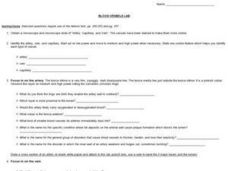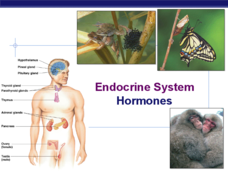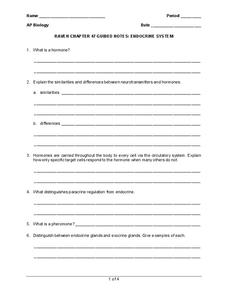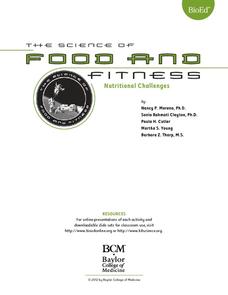Curated OER
Construction of a Hemoglobin Gene
Pupils see how eight pairs of triplets are equivalent to part of a gene and control a part of heredity. They comprehend how blood corpuscles manufacture normal hemoglobin. Students already comprehend that genes control the synthesis of...
Curated OER
In the Future we will all be Mixed Bloods and Mestizoes
Young scholars examine the concept of origin and ethnicity. In this ethnic studies lesson, students engage in a variety of interdisciplinary activities including posters, and discussions to better understand our past and future.
Curated OER
Fighting Back!
Fifth graders inspect the basic functions of the immune system and determine how viruses and bacteria invade the immune system. They also explore what happens to the immune system in outer space.
Curated OER
Blood Brothers
Students study the blood characteristics of a number of distinct racial/ethnic groups. They build skills in observation, information gathering and processing. Students experiences strongly reflect the nature and intent of the current...
Curated OER
Blood Vessels Lab
In this blood vessel worksheet, students compare microscope slides of arteries, veins, and capillaries. This worksheet has 43 fill in the blank questions.
Curated OER
Born of Blood
Students define attributes of human chromosomes and match them to make a human karyotype. In this investigative lesson students demonstrate how traits are encoded in genes found on chromosomes.
Curated OER
Endocrine System: Hormones
The many images and labeled diagrams in this PowerPoint will help learners understand different areas of the endocrine system. The slide
show starts with information about the absorption of lipid and protein based hormones, and then...
Smarter Balanced
Classifying Vertebrates
What features do scientists use to classify animals into groups? Class groups examine a series of paired images of vertebrates (a bass and a trout, a toad and a newt, a crocodile and a tortoise, an owl and a robin, a tiger and a bear)...
Biology in Motion
The Cardiovascular System
When resting, blood goes from the heart to the lungs and back in about six seconds. An animation of the heart starts simply by showing blood flow through the two halves. It builds in complexity slowly over the course of five slides,...
Nemours KidsHealth
Human Body Series: Immune System
When you work with school children, teaching about immunity and illness prevention is a priority! This approach includes a discussion, kid-friendly online articles, a creative writing assignment, and a quiz on the role of leukocytes and...
Howard Hughes Medical Institute
How Do Fibers Form?
The proteins inside a cell determine the shape of the cell. While most red blood cells have a circular shape, those with sickle cell take the shape of a sickle. This change in shape causes multiple issues in the system. Scholars solve...
Curated OER
Hands on Your Heart - Biology Teaching Thesis
Learners are able to recite the circulation of blood through the heart's various cavities and valves. They are able to appreciate what the actual valves and chambers of the heart look like. Students also have a clear vision of why the...
Curated OER
Diving Whale Sculpture
Students identify two types of whales: toothed whales and baleen whales, and understand that whales come to the surface for air. Then they recognize that whales are mammals (they nurse their young and are warm-blooded). Students also...
Curated OER
Endocrine System
Explain, distinguish, list, and describe the structure and function of the human endocrine system. Medical school hopefuls also diagram how calcium, glucose, and osmotic levels are regulated in the blood. This worksheet is suitable for...
Curated OER
Mathematics in Bioengineering: Its Application for Today's Students
High schoolers explore the different fields of bioengineering. They will create and interpret graphs from cancel cells data. They then calculate the amount of drugs found in blood and eliminated by the body over time.
Curated OER
First-aid Safety Skills
Everyone gets minor cuts and scrapes now and then. Provide your special education class with the skills they needs to clean and bandage a small wound. Use read marker (fake blood) on your arm and show your class how to wash and dress it....
Council for the Curriculum, Examinations and Assessment
Health and the Whole Person
Health is more than measuring your blood pressure and eating nutritious foods. Eighth graders discuss the factors that play into an individual's health, including spirituality, social life and friendships, emotional stability, cognitive...
EngageNY
Grade 10 ELA Module 4, Unit 2, Lesson 26
How do directors' choices emphasize different elements of a drama? Scholars participate in a discussion about the Royal Shakespeare Company production of Macbeth and Akira Kurosawa's Throne of Blood. Finally, they write an analysis of...
EngageNY
Grade 10 ELA Module 4, Unit 2, Lesson 24
What might viewers notice about the characters, setting, and cinematic choices in the movie version of a play? Pupils view an excerpt from Throne of Blood, Akira Kurosawa's film adaptation of Shakespeare's Macbeth. To finish the...
Howard Hughes Medical Institute
Icefish Adaptations
What adaptations exist in order for icefish to survive the subfreezing temperatures of the Antarctic Ocean? Middle and high schoolers can find out through watching a related 13-minute video and performing a simple investigation to...
BioEd Online
Nutritional Challenges
Eating healthy can be a challenge, especially for people with special dietary needs. After learning about standard nutritional needs for adults, learners take on the role of a dietician and work together to create a menu for one of the...
Baylor College
Modeling an HIV Particle
Models are an important part of science; they help us see the world on a scale that works for us. In the first of five lessons on HIV, learners make a paper model of the HIV virus that is about 500,000 times larger than the actual virus....
Curated OER
The Brain’s Inner Workings
Do you want to learn about how you learn? Help pupils become the best learners they can be by teaching them how their brain works. The resources available include videos about brain structure and a study guide full of activities that...
Reed Novel Studies
Julie of the Wolves: Novel Study
Blood may not always be thicker than water. Julie, in Julie of the Wolves, soon depends on a wolf pack to be her family. Scholars read about Julie's adventures as they complete sentences with vocabulary words, answer comprehension...
Other popular searches
- In Cold Blood
- Blood Pressure
- Blood Types
- Blood Vessels
- Blood Flow
- Blood Platelets
- Blood Cells
- Forensic Science Blood Type
- Blood Circulation
- Red & White Blood Cells
- Blood Typing
- Cold Blooded






















